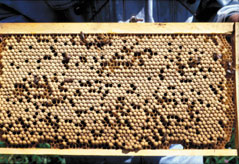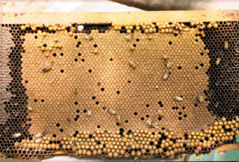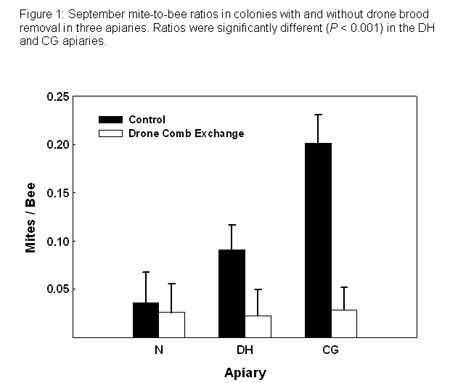
IPM Non-Chemical Control Methods
Drone brood removal research
Mites are found most often on drone brood where they produce about twice as many offspring as on worker brood. Therefore, by removing capped drone brood from an infected colony, you remove a disproportionately large number of mites without affecting the worker population, and you remove those mites with the highest fecundity. Research at Dyce Laboratory for Honey Bee Studies at Cornell University has shown that the periodic removal of drone brood from a colony allows a beekeeper to skip the usual spring treatment, keep mite levels low throughout the summer and prevent fall collapse (figure 1). It may also eliminate the need for a fall pesticide treatment. The only way to determine that is to estimate the pest density on a colony-by-colony basis after removing the fall honey crop.

Implementation: You will need four drone combs per colony to use this method. Drone foundation can be purchased from several supply houses. The foundation is wired into frames and drawn out by colonies. One piece plastic drone combs are also available. Use two deep hive bodies for brood chambers, and separate them from the honey supers with a queen excluder. Cull worker combs in the brood nest with more than 1 to 2 square inches of drone cells (photo H). Remember! The goal is to get the colony to consolidate all of its drone production in the removable drone combs.
Place two drone combs in the upper brood chamber, one or two combs in from each side. Visit your colony every 26 to 28 days, remove the drone combs (photo I) and replace them with the drone combs that you removed on the previous replacement date. Place the combs of capped drone brood in a freezer, and keep them there until you are ready for your next exchange. Allow frozen drone combs to come to ambient temperature before placing them back in a colony. Be sure to visit your bees at least every 28 days to exchange combs because you don't want too many drones actually emerging in your hive. If a drone comb becomes filled with honey, you will need to substitute an empty drone comb and extract the honey before reusing it. In the north, you can exchange combs up to six times a season using a 28-day interval between exchanges. The more often you exchange combs, the more you will suppress the mite population. The drone brood removal method has no known deleterious effects on colonies, and honey production may be marginally increased.

